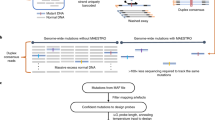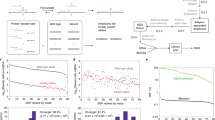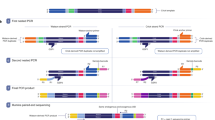Abstract
Oligonucleotide microarray (DNA chip)–based hybridization analysis is a promising new technology which potentially allows rapid and cost–effective screens for all possible mutations and sequence variations in genomic DNA. Here, I review current strategies and uses for DNA chip–based resequencing and mutational analysis, the underlying principles of experimental designs, and future efforts to improve the sensitivity and specificity of chip–based assays.
This is a preview of subscription content, access via your institution
Access options
Subscribe to this journal
Receive 12 print issues and online access
$209.00 per year
only $17.42 per issue
Buy this article
- Purchase on Springer Link
- Instant access to full article PDF
Prices may be subject to local taxes which are calculated during checkout





Similar content being viewed by others
References
Collins, F.S., Guyer, M.S. & Chakravarti, A. Variations on a theme: cataloging human DNA sequence variation. Science 278, 1580– 1581 (1997).
Nickerson, D.A. et al. DNA sequence diversity in a 9.7–kb region of the human lipoprotein lipase gene. Nature Genet. 19, 233–240 (1998).
Chakravarti, A. Population genetics—making sense out of sequence. Nature Genet. 21, 56–60 ( 1999).
Moldin, S.O. & Gottesman, I.I. At issue: genes, experience and chance in schizophrenia—positioning for the 21st century. Schizophr. Bulletin 23, 547–561 (1997).
Zhang, H., Zhao, H. & Merikangas, K. Strategies to identify genes for complex diseases. Ann. Med. 29, 493–498 ( 1998).
Southern, E.M. DNA chips: analysing sequence by hybridization to oligonucleotides on a large scale. Trends Genet. 12, 110– 115 (1996).
Ramsay, G. DNA chips: state–of–the art. Nature Biotechnol. 16, 40–44 (1998).
Duggan, D.J., Bittner, M., Chen, Y., Meltzer, P. & Trent, J. Expression profiling using cDNA microarrays. Nature Genet. 21, 10–14 (1999).
Schena, M., Shalon, D., Davis, R.W. & Brown, P.O. Quantitative monitoring of gene expression patterns with a complementary DNA microarray. Science 270, 467–470 ( 1995).
Lockhart, D.J. et al. Expression monitoring by hybridization to high–density oligonucleotide arrays. Nature Biotechnol. 14, 1675–1680 (1996).
Bains, W. & Smith, G. A novel method for nucleic acid sequence determination. J. Theor. Biol. 135, 303– 307 (1988).
Khrapko, K.R. et al. An oligonucleotide hybridization approach to DNA sequencing. FEBS Lett. 256, 118–122 (1989).
Drmanac, R., Labat, I., Brukner, I. & Crkvenjakov, R. Sequencing of megabase plus DNA by hybridization: theory of the method. Genomics 4, 114–128 ( 1989).
Southern, E.M., Maskos, U. & Elder, J.K. Analyzing and comparing nucleic acid sequences by hybridization to arrays of oligonucleotides: evaluation using experimental models. Genomics 13, 1008–1017 ( 1992).
Drmanac, S. et al. Accurate sequencing by hybridization for DNA diagnostics and individual genomics. Nature Biotechnol. 16, 54–58 (1998).
Fodor, S.P.A. et al. Light–directed spatially addressable parallel chemical synthesis. Science 251, 767– 773 (1991).
Lipshutz, R.J., Fodor, S.P.A., Gingeras, T.R. & Lockhart, D.J. High density synthetic oligonucleotide arrays. Nature Genet. 21, 20–24 (1999).
Marshall, A. & Hodgson, J. DNA chips: an array of possibilities. Nature Biotechnol. 16, 27– 31 (1998).
Schena, M. et al. Microarray: biotechnology's discovery platform for functional genomics. Trends Biotechnol. 16, 301– 306 (1998).
Saiki, R.K., Walsh, P.S., Levenson, C.H. & Erlich, H.A., Genetic analysis of amplified DNA with immobilized sequence–specific oligonucleotide probes. Proc. Natl Acad. Sci. USA 86 , 6230–6234 (1989).
Cronin M.T. et al. Cystic fibrosis mutation detection by hybridization to light–generated DNA probe arrays. Hum. Mutat. 7, 244– 255 (1996).
Yershov, G. et al. DNA analysis and diagnostics on oligonucleotide microchips. Proc. Natl Acad. Sci. USA 93, 4913– 4918 (1996).
Cooper, D.N., Smith, B.A., Cooke, H.J., Niemann, S. & Schmidtke, J. An estimate of unique DNA sequence heterozygosity in the human genome. Hum. Genet. 69, 201– 205 (1985).
Hofker, M.H. et al. The X chromosome shows less genetic variation at restriction sites than the autosomes. Am. J. Hum. Genet. 39, 438–451 (1986).
Chee, M. et al. Accessing genetic information with high–density DNA arrays. Science 274, 610–614 (1996).
Hacia, J.G., Brody, L.C., Chee, M.S., Fodor, S.P. & Collins, F.S. Detection of heterozygous mutations in BRCA1 using high density oligonucleotide arrays and two–colour fluorescence analysis. Nature Genet. 14, 441– 447 (1996).
Pastinen, T., Kurg, A., Metsapalu, A., Peltonen, L. & Syvanen, A.C. Minisequencing: a specific tool for DNA analysis and diagnostics on oligonucleotide arrays. Genome Res. 7, 606–614 (1997).
Kozal, M. et al. Extensive polymorphisms observed in HIV–1 cladeB protease gene using high–density oligonucleotide arrays. Nature Med. 2, 753–759 ( 1996).
Hacia, J. et al. Strategies for mutational analysis of the large multi–exon ATM gene using high–density oligonucleotide arrays. Genome Res. (in press).
Wang, D.G. et al. Large–scale identification, mapping, and genotyping of single–nucleotide polymorphisms in the human genome. Science 280, 1077–1082 ( 1998).
Shumaker, J.M., Metspalu, A. & Caskey, C.T. Mutation detection by solid phase primer extension. Hum. Mutat. 7, 346–354 (1996).
Nikiforov, T.T. et al. Genetic bit analysis: a solid phase method for typing single nucleotide polymorphisms. Nucleic Acids Res. 22, 4167–4175 (1994).
Head, S.R. et al. Nested genetic bit analysis (N–GBA) for mutation detection in the p53 tumor suppressor gene. Nucleic Acids Res. 25, 5065–5071 (1997).
McGall, G. et al. Light–directed synthesis of high–density oligonucleotide arrays using semiconductor photoresists. Proc. Natl Acad. Sci. USA 93, 13555–13560 ( 1996).
Blanchard, A.P., Kaiser, R.J. & Hood, L.E. High–density oligonucleotide arrays. Biosens. Bioelectron. 11, 687–690 (1996).
Proudnikov, D., Timofeev, E. & Mirzabekov, A. Immobilization of DNA in polyacrylamide gel for the manufacture of DNA and DNA–oligonucleotide microchips. Anal. Biochem. 259, 34–41 ( 1998).
Hacia, J.G. et al. Evolutionary sequence comparisons using high–density oligonucleotide arrays. Nature Genet. 18, 155–158 (1998).
The Huntington's Disease Collaborative Research Group. A novel gene containing a trinucleotide repeat that is expanded and unstable on Huntington's disease chromosomes. Cell 72, 971–983 (1993).
Milner, N., Mir, K.U. & Southern, E.M. Selecting effective antisense reagents on combinatorial oligonucleotide arrays. Nature Biotechnol. 15, 537–541 (1997).
Southern, E. Mir, K. & Shchepinov, M. Molecular interactions on microarrays. Nature Genet. 21, 5–9 ( 1999).
Simone, N.L., Bonner, R.F., Gillespie, J.W., Emmert–Buck, M.R. & Liotta, L.A. Laser–capture microdissection: opening the microscopic frontier to molecular analysis. Trends Genet. 14, 272–276 (1998).
Hoheisel, J.D. Sequence–independent and linear variation of oligonucleotide DNA binding stabilities. Nucleic Acids Res. 24, 430– 432 (1996).
Weiler, J., Gausepohl, H., Hauser, N., Jensen, O.N. & Hoheisel, J.D. Hybridisation based DNA screening on peptide nucleic acid (PNA) oligomer arrays. Nucleic Acids Res. 25, 2792–2799 ( 1997).
Arlinghaus, H.F., Kwoka, M.N. & Jacobson, K.B. Analysis of biosensor chips for identification of nucleic acids. Anal. Chem. 15, 3747– 3753 (1997).
Hacia, J.G. et al. Enhanced high density oligonucleotide array– based sequence analysis using modified nucleoside triphosphates. Nucleic Acids Res. 26, 4975–4982 ( 1998).
Nguyen, H.K. et al. The stability of duplexes involving AT and/or G4EtC base pairs is not dependent on their AT/G4EtC ratio content. Implication for DNA sequencing by hybridization. Nucleic Acids Res. 26, 4249–4258 (1998).
Hacia, J.G. et al. Two color hybridization analysis using high density oligonucleotide arrays and energy transfer dyes. Nucleic Acids Res. 26, 3865–3866 (1998).
Lizardi, P.M. et al. Mutation detection and single–molecule counting using isothermal rolling–circle amplification. Nature Genet. 19, 225–232 (1998).
Edman, C.F. et al. Electric field directed nucleic acid hybridization on microchips. Nucleic Acids Res. 25, 4907– 4914 (1997).
Sosnowski, R.G., Tu, E., Butler, W.F., O'Connell, J.P. & Heller, M.J. Rapid determination of single base mismatch mutations in DNA hybrids by direct electric field control. Proc. Natl Acad. Sci. USA 94, 1119–1123 ( 1997).
Broude, N.E., Sano, T., Smith, C.L. & Cantor, C.R. Enhanced DNA sequencing by hybridization. Proc. Natl Acad. Sci. USA 91, 3072–3076 (1994).
Dubiley, S., Kirillov, E., Lysov, Y. & Mirzabekov, A. Fractionation, phosphorylation and ligation on oligonucleotide microchips to enhance sequencing by hybridization. Nucleic Acids Res. 25, 2259–2265 (1997).
Parinov, S. et al. DNA sequencing by hybridization to microchip octa– and decanucleotides extended by stacked pentanucleotides. Nucleic Acids Res. 24, 2998–3004 ( 1996).
Sanger, F., Nicklen, S. & Coulson, A.R. DNA sequencing with chain–terminating inhibitors. Proc. Natl Acad. USA 74, 5463– 5467 (1977).
Wilson, R.K., Chen, C., Avdalovic, N., Burns, J. & Hood, L. Development of an automated procedure for fluorescent DNA sequencing. Genomics 6, 626–634 ( 1990).
Acknowledgements
I thank L. Brody, F. Collins, K. Edgemon, A. Mayer and B. Sun from NIH for helpful suggestions and discussion. I also thank M. Chee at Illumina, M. Cronin at Protogene, S. Fodor at Affymetrix and N. Hunt at GeneTrace for comments and discussion.
Author information
Authors and Affiliations
Rights and permissions
About this article
Cite this article
Hacia, J. Resequencing and mutational analysis using oligonucleotide microarrays . Nat Genet 21 (Suppl 1), 42–47 (1999). https://doi.org/10.1038/4469
Issue Date:
DOI: https://doi.org/10.1038/4469
This article is cited by
-
Detection of genetic variation using dual-labeled peptide nucleic acid (PNA) probe-based melting point analysis
Biological Procedures Online (2015)
-
Rapid Catch and Signal (RCS) Technology Platform: Multiplexed Three-Color, 30 s Microwave-Accelerated Metal-Enhanced Fluorescence DNA Assays
Plasmonics (2014)
-
Simultaneous detection of major enteric viruses using a combimatrix microarray
Journal of Microbiology (2012)
-
A high-throughput resequencing microarray for autosomal dominant spastic paraplegia genes
neurogenetics (2012)
-
Novel Sequencing-based Strategies for High-Throughput Discovery of Genetic Mutations Underlying Inherited Antibody Deficiency Disorders
Current Allergy and Asthma Reports (2011)



